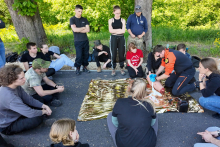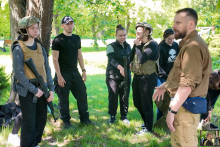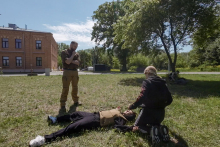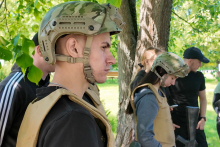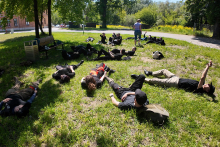- In the lecture hall, we can show certain schemes, but later we have to collide them with reality, in order to develop techniques that are reproducible, repeatable and, above all, realistic in an emergency situation. - explains Jakub Zachaj, an academic teacher and coordinator of the tactical medicine - When we perform something in the field, we collide it with, for example, distances, changing weather, terrain, which cannot be reproduced in the lecture hall, but can affect how we will give aid or conduct an evacuation.
Paramedic in tactical conditions
Our students and their chaperones traveled all the way to Nowy Dwór Mazowiecki. It is there that the Fire University's Field Training and Rescue Innovation Base is located, and the classes were held there.
The exercises were divided into three parts. At the beginning, the students listened to a lecture, from which they learned what actions they should perform at the various stages of assisting the injured under the hazardous conditions that face rescuers.
The second part consisted of practicing the interventions most commonly performed by rescuers under tactical conditions. Thus, students practiced conducting a trauma examination suitable for implementing the MARCH PAWS algorithm, dressing massive hemorrhages with a tourniquet, as well as hemorrhages from junctional areas.
An important part of the training was a self-rescue exercise. The students had to cope with applying tourniquets, also with the non-dominant hand. They coped with this very efficiently.
The final stage involved combining all the elements discussed, as well as knowledge and skills from other classes, such as disaster medicine, and applying them to the conditions of a simulated incident with a large number of victims. A large number of casualties, an open area, the risk of re-attack. Such a scenario to be played out by the students was prepared by the class instructors.
In addition to strictly medical skills, the students had to demonstrate correct assessment of the situation as well as the speed and accuracy of their decisions. Teamwork and team communication skills also counted.
Classes that stay in memory
The classes were very much enjoyed by the emergency medicine students, they approached all exercises with enthusiasm. But they were not the only ones. The group of paramedics was also joined by five medical students, interested in introducing such a subject to their curriculum. They also evaluated the classes very positively. The group of medical students was accompanied by the Dean of the Faculty, Professor Paweł Włodarski. Students from the Fire University also participated in the exercises from the very beginning.
- Outdoor classes are an excellent addition to the study program. They show that we will not always work in “ideal” conditions. And also that our decisions are influenced by many more external factors. Factors that also affect the injured person. However, it is possible to develop appropriate patterns of action - concludes Jakub Zachaj.

